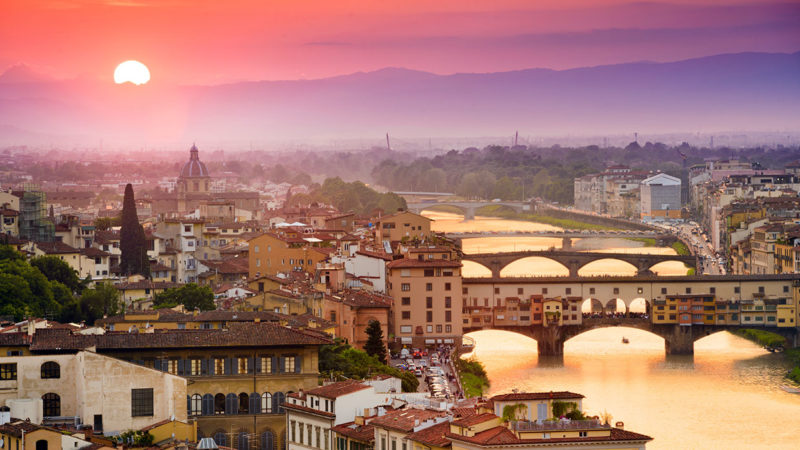The capital of Italy’s Tuscany region is home to many interesting secrets…

Florence has so much history and culture to offer. Here’s our A-Z of all things Florence.
ARNO
The river that flows through central Florence begins at Monte Falterona in the Apennines and flows 241km from there to the Ligurian Sea.
BOTTICELLI
The prolific Florentine artist was born Alessandro di Mariano Filipepi in 1445. His masterpieces, Primavera and The Birth of Venus, are both housed in the Uffizi.
CAPITAL CITY
In 1865, Florence replaced Turin as the capital of Italy, but relinquished the honour to Rome just six years later.
DANTE ALIGHIERI
The 14th-century Florentine writer and poet is remembered for his literary masterpiece, The Divine Comedy.
ERBORISTERIA INGLESE
The famous herbalist’s, situated on Via de’ Tornabuoni, was founded in 1843 by the Englishman Henry Roberts.
FLOODING
The River Arno is prone to flooding and did so with devastating effect on 4 November 1966, killing 101 people and damaging countless works of art.
GALILEO GALILEI
The scientific genius, persecuted by the Catholic Church, died under house arrest in Arcetri, just outside Florence, in 1642.
HANNIBAL
The follow-up to The Silence of the Lambs was filmed in Florence and many of the city’s landmarks appear in the movie.
ISOLOTTO
The island and lake in the Boboli Gardens were designed in the 17th century by Giulio and Alfonso Paigi.
JULIUS CAESAR
Considered the father of Florence, he founded the settlement of ‘Florentia’ for retired soldiers at the narrowest point of the Arno in 59 BC.
KYOTO
Florence was twinned with this historic, temple-filled city and former capital of Japan in 1965. Other sister cities include Edinburgh and Sydney.
LEONARDO DA VINCI
The celebrated artist, engineer, scientist and all-around genius spent his youth in Florence as an apprentice to Verrocchio. Their joint work, The Baptism of Christ, hangs in the Uffizi.
MEDICI
The dynasty, which produced four popes and two French queens, ruled Florence between the 15th and 18th centuries. Look out for the family emblem of six balls on buildings all over Florence.
NUTRIAS
Not giant rats, but vegetarian, semi-aquatic rodents. Also known as coypu, they were introduced to Italy in 1928 and can often be spotted swimming in the Arno.
OLTRARNO
The characterful Florentine district ‘beyond the Arno’ lies just south of the river, on the opposite side to the Duomo.
PLAGUE
The Black Death devastated Florence in 1348, killing over half of the city’s population. It is the background setting to Boccaccio’s Decameron.
QUARTIERI MONUMENTALI
Housed in the Palazzo Vecchio in Florence’s centro storico and filled with some incredible works of art, the Quartieri Monumentali were the main quarters of the Medici family.
RENAISSANCE
This major 14th-century cultural movement, which revised and revisited Classical themes, is closely associated with Florence and is considered by many to have begun in the Tuscan region.
STENDHAL SYNDROME
Named after the pseudonym of French author Henri-Marie Beyle (1783-1842), who visited Florence in 1817. The syndrome is characterised by palpitations and dizziness, and is brought on by excessive exposure to beautiful works of art.
TRIPPAI
These stalls all across the city sell dishes of tripe and lampredotto (made from the cow’s fourth stomach).
UFFIZI
The famous museum is packed full of priceless works of art, including treasures by Michelangelo, Titian, Caravaggio and Raphael.
VIOLET
Considered to be lucky in Florence, which is why this colour is worn by the city’s football team, ACF Fiorentina.
WORLD HERITAGE SITE
The historical centre of Florence is designated a World Heritage Site by UNESCO.
X-COMMUNICATED
The infamous Bonfire of the Vanities, which took place in 1497 under the direction of the monk Girolamo Savonarola, saw the city’s excesses burned in a giant bonfire.
YARN
During the 14th century, the wool trade was a major economic force in the city, employing thousands of people.
ZUCCONE
‘Big marrow’ (figuratively ‘dimwit’): the nickname for Donatello’s Habakkuk in the Museo dell’Opera.
Find more Italian Culture in our archive.
